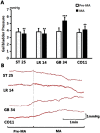Bi-directional regulation of acupuncture on extrahepatic biliary system: An approach in guinea pigs
- PMID: 29070912
- PMCID: PMC5656652
- DOI: 10.1038/s41598-017-14482-x
Bi-directional regulation of acupuncture on extrahepatic biliary system: An approach in guinea pigs
Abstract
Clinically, acupuncture affects the motility of the extrahepatic biliary tract, but the underlining mechanisms are still unknown. We applied manual acupuncture (MA) and electrical acupuncture (EA) separately at acupoints Tianshu (ST25), Qimen (LR14), Yanglingquan (GB34), and Yidan (CO11) in forty guinea pigs (4 groups) with or without atropinization under anesthesia while Sphincter of Oddi (SO) myoelectric activities and gallbladder pressure were monitored. In both MA and EA groups, stimulation at ST25 or LR14 significantly increased the frequency and amplitude of SO myoelectrical activities and simultaneously decreased the gallbladder pressure as compared to the pre-MA and pre-EA (P < 0.05). On the contrary, stimulation at GB34 or CO11 significantly decreased SO myoelectricity and increased the gallbladder pressure (P < 0.05). Pretreatment with atropine could abolish the effect of stimulation at acupoints ST25, GB34 and LR14 (P > 0.05), although significant myoelectricity increases were still inducible with MA or EA stimulation at CO11 (P < 0.05). In summary, acupuncture has bi-directional effects to gallbladder pressure and SO function, which probably due to autonomic reflex and somatovisceral interactions.
Conflict of interest statement
The authors declare that they have no competing interests.
Figures









Similar articles
-
A brief commentary: electroacupuncture may relax the contraction of sphincter of Oddi.J Altern Complement Med. 2001;7 Suppl 1:S119-20. doi: 10.1089/107555301753393887. J Altern Complement Med. 2001. PMID: 11822626
-
[Extrahepatic bile duct movement and bile excretion during vomiting in dogs].J Smooth Muscle Res. 1995 Dec;31(6):416-7. J Smooth Muscle Res. 1995. PMID: 8867954 Japanese. No abstract available.
-
Afferent mechanisms underlying stimulation modality-related modulation of acupuncture-related cardiovascular responses.J Appl Physiol (1985). 2005 Mar;98(3):872-80. doi: 10.1152/japplphysiol.01079.2004. Epub 2004 Nov 5. J Appl Physiol (1985). 2005. PMID: 15531558
-
Sphincter of Oddi motility.Acta Chir Scand Suppl. 1990;553:1-35. Acta Chir Scand Suppl. 1990. PMID: 2184636 Review.
-
Sphincter of Oddi function and dysfunction.Can J Gastroenterol. 2000 May;14(5):411-9. doi: 10.1155/2000/313601. Can J Gastroenterol. 2000. PMID: 10851282 Review.
Cited by
-
The cerebral mechanism underlying the acupoints with specific effect for gallbladder stone disease: protocol for a randomized controlled task-fMRI trial.Trials. 2021 Jun 14;22(1):399. doi: 10.1186/s13063-021-05356-9. Trials. 2021. PMID: 34127059 Free PMC article.
-
RNA Sequencing Analysis of Gene Expression by Electroacupuncture in Guinea Pig Gallstone Models.Evid Based Complement Alternat Med. 2022 Jan 7;2022:3793946. doi: 10.1155/2022/3793946. eCollection 2022. Evid Based Complement Alternat Med. 2022. PMID: 35035504 Free PMC article.
-
Analysis of Acupoints Combination for Cancer-Related Anorexia Based on Association Rule Mining.Evid Based Complement Alternat Med. 2022 Oct 18;2022:4251458. doi: 10.1155/2022/4251458. eCollection 2022. Evid Based Complement Alternat Med. 2022. PMID: 36304134 Free PMC article.
-
Mechanisms Underlying the Prevention and Treatment of Cholelithiasis Using Traditional Chinese Medicine.Evid Based Complement Alternat Med. 2019 Jun 17;2019:2536452. doi: 10.1155/2019/2536452. eCollection 2019. Evid Based Complement Alternat Med. 2019. PMID: 31316569 Free PMC article. Review.
-
Immediate acupuncture with GB34 for biliary colic: protocol for a randomised controlled neuroimaging trial.BMJ Open. 2022 Jan 13;12(1):e050413. doi: 10.1136/bmjopen-2021-050413. BMJ Open. 2022. PMID: 35027415 Free PMC article.
References
Publication types
MeSH terms
LinkOut - more resources
Full Text Sources
Other Literature Sources
Medical

